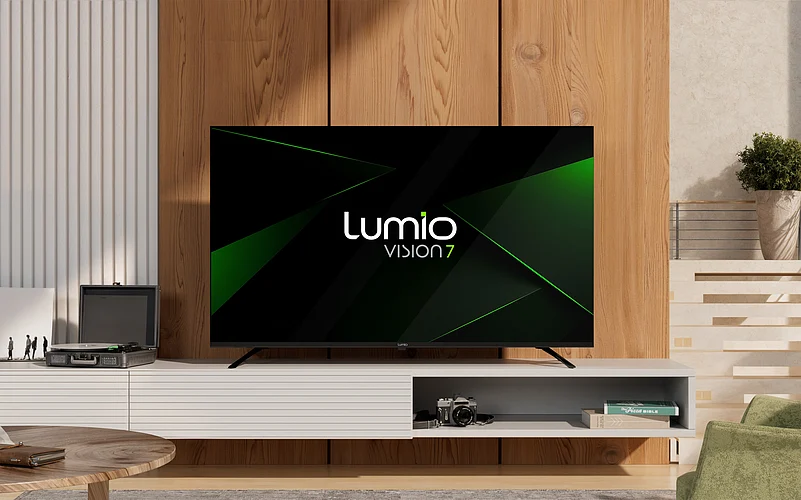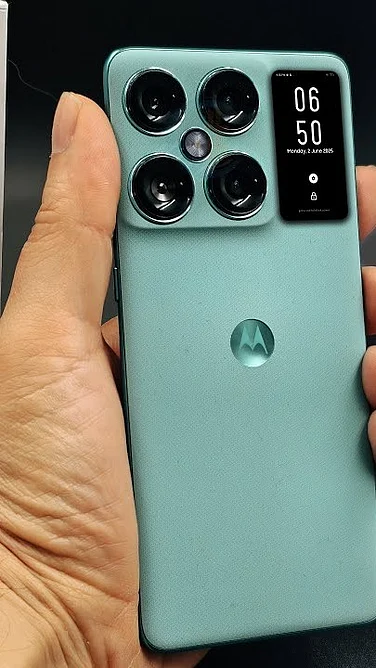Fast & Furious. Ferrari. Usain Bolt. Faith Kipyegon. These are just some of the things and people that are super duper fast. Now, you can add the Lumio Vision 7 QLED TV to that list. You may have never heard of a brand called Lumio, and that’s alright. Circuit House Technologies’ Lumio brand has come swinging right out of the gate, and you’ll be hearing all about them over the next few weeks and months.
If you think you’ve got a slow TV at home, then you’re due for an upgrade. Lumio is here to solve the problem of slow TVs without the need for an external Apple TV box or an Amazon Fire TV Stick. The company is debuting in India (with no plans to expand beyond its current borders) with two TV models: Vision 7 and Vision 9. I got the former for review and boy, was I impressed.
The smart TV market in India is seeing an explosion in the under Rs 50,000 segment, and Lumio is here to add fuel to the fire. The Lumio Vision 7 is available in three sizes: 43-inch, 50-inch, and 55-inch, all featuring 4K resolution. They are QLED TVs. On the other hand, the Vision 9 comes in a single 55-inch size and is a 4K mini-LED panel.
The 55-inch Vision 7, which I’ve been testing for a few weeks before publishing this review, retails for Rs 39,999, a price that is frankly very aggressive for what is offered. With blazing-fast performance at its core, the Lumio 7 is a TV worth being on top of your shopping list. While performance may be its USP, the TV doesn’t compromise on the basics.
Price-Sensitive Market
The under Rs 50,000 price segment has seen an explosion of options over the last few years. The smart TV market in India has never been more competitive. To carve out a significant market share will be a challenging task, even for established players like Xiaomi. Consumers are now demanding much more (immersive viewing experiences) for much less (money). 4K is a must in this segment. Dolby Vision, Android TV support, smart voice assistant and other things are bonuses. The bottom line is that TVs nowadays need to be smart-ready, as consumers in this price segment don’t want to purchase an additional device, such as an Amazon Fire TV Stick, to access their favourite apps (Netflix, Amazon Prime Video, JioHotstar, and others).
The major players, such as Samsung, LG, and Sony, have had to launch affordable models that compromise on quality. So far, they’ve been unsuccessful. It’s on the onus of Xiaomi, and now Lumio, to up the game for the consumers.
Minimalistic Design
Before I delve into the TV's performance, let me take a moment to discuss its design. Yes, the Vision 7 features an edge-to-edge display on three sides. The bottom bezel is the thicker one, but it also features the Lumio logo.
At first glance, the TV reels you in with its modern and minimalistic design. It’s slim, and there’s little you can complain about here. It’s been constructed from plastic, and I had it mounted on a stand (two separate legs). You don’t get any wall mount accessories in the box. It's a giant 55-inch TV, and it will stare you in the face. Still, you’ll be immersed in the content in no time.
There’s a metallic frame (and back panel), while the rest is made of plastic. The device features three HDMI 2.1 ports (one with eARC support, which is much needed), one USB 3.1 port, two USB 2.0 ports, and an Ethernet (RJ45) port. There’s even an AV mini input and an optical port.
The Minion remote was my favourite part. That’s where I got the TV going. It’s easy to learn all the controls, so even in pitch darkness, you can still control the volume with relative ease. But what’s new on this remote is the TLDR button (more on that later).
Performance is King
The display may be limited to 60Hz, but on a TV, it’s something you’d hardly notice. The 4K resolution, though, is the icing on the cake. The visuals were crisp, and the content popped. The technology (which I won't get into) is complemented by Lumio’s proprietary “DOPE” display engine. I don’t know how, but it just appealed to me from the get-go. I was like, “woah”, the first time I had laid my eyes on the television.
With excellent viewing angles, multiple people can sit around the room and enjoy the content. The only downside is that this isn’t OLED. You aren’t getting true blacks. The purists may want to stay away. However, in this price range, no one can afford a TV with true blacks. So that’s a trade-off you’ll have to make before purchasing the Vision 7.
To access the content, the TV must go through its motions. You need to locate the remote, press the power button, wait for the interface (in this case, Google TV) to load, and then scroll through it to find the app you’re looking for and launch it. Thereafter, the app needs to load before you can scroll through it and see precisely what you want to watch. Sounds easy, right? I’ve tested numerous TVs in this price range, as well as those slightly higher. Let me tell you something. They are slow. Those extra few seconds it takes to load are noticeable. Lumio is built to avoid the “slowdown” curse. I’ve had it for about a month now, and not once has an app loaded slowly. Wimbledon is currently going on, and a match I wanted to watch was at deuce. Before it got to the advantage point, I was already in the JioHotstar app, having chosen the game I wanted to watch.
The BOSS processor is at the heart of the performance. Lumio did not skimp on this TV. The TV is loaded, compared to the competition. The TV features a quad-core CPU, 3GB of DDR4 RAM, and 16GB of storage.
Sound (just buy a soundbar)
The DGS Audio setup (two tweeters and two full-range drivers) that delivers an output of 30W is fine, just fine. Yes, for a large part of my review period, I watched and consumed content without the soundbar. But there were many times I was missing that “oomph” factor.
The first thing to consider is that the Vision 7’s sound doesn’t get loud enough. While watching Wimbledon, or these days, the Tour de France, I wanted to be completely engulfed. As if I were there watching it live. And while the sound delivered a clear and balanced sound, it wasn’t punchy enough. The grunts from the tennis players seemed to fall away. You do get Dolby Atmos support, which I highly appreciate, but it isn’t enough. Yes, the sound on the Vision 7 is better than most TVs in this range. But honestly, just go out and buy a soundbar and do yourself a favour. I constantly had the TV volume at 50-60 percent, and I was still not delighted. Perhaps Vision 9 offers a better and more immersive sound experience.
A Few Niggles
I experienced a few software issues with the Vision 7, but I would attribute them to being a Google TV issue rather than Lumio’s fault. However, with Lumio working closely with Google TV, I hope a software update or two can resolve the issue.
First, I encountered a problem where an app crash would also cause the Google TV interface to crash. And no button would work to rectify it. It continued to loop in a “trying to start the homepage” cycle, and only a power cycle (off and then on) would resolve the issue. The issue primarily occurred with SonyLIV, but also affected one or two other apps. But I couldn’t rectify it if I wanted to. It just seemed to happen randomly. Even a full reset didn’t seem to fix it.
The second issue I had was casting from an app. I was trying to stream a cricket match from Fancode. I opened the app on my phone, clicked on the game I wanted to watch, and then hit the “Cast to TV” button. It worked for a few seconds, allowing me to watch one ball being bowled, but then it crashed. Three or four times, I had to cast it before the connection was stable. Again, it could be a Fancode app issue more than anything else. Lumio has promised regular software updates, and I sure hope they’ll fix it soon.
Verdict: A Refreshing Entry
Buy yourself a Lumio Vision 7, then go shopping for a soundbar to complement it. Come home after the purchase, unbox it, plug it in, and enjoy the grunts of Novak Djokovic from the comfort of your couch. Yes, that’s the best way to sum up my experience with the television.
I didn’t touch upon their TLDR app, something Lumio is building to differentiate itself from the crowd. And while I appreciate it, I’d like to see it evolve some more before giving my final thoughts.
Lumio set out to address a problem that most consumers in this price segment faced: speed. And they’ve done it with aplomb. It’s a blazing-fast TV with punchy colours and crisp textures. No deep blacks, and not the best-in-class sound experience, but other than that, one can hardly complain.
Lumio is a refreshing entry into the TV market, and I’m so glad they’re here to slay the competition. After the success of their TVs, the company has now delved into projectors. Only time will tell whether both are a hit or not.
When I review the projector, I’ll be sure to touch upon the updated TLDR app.































